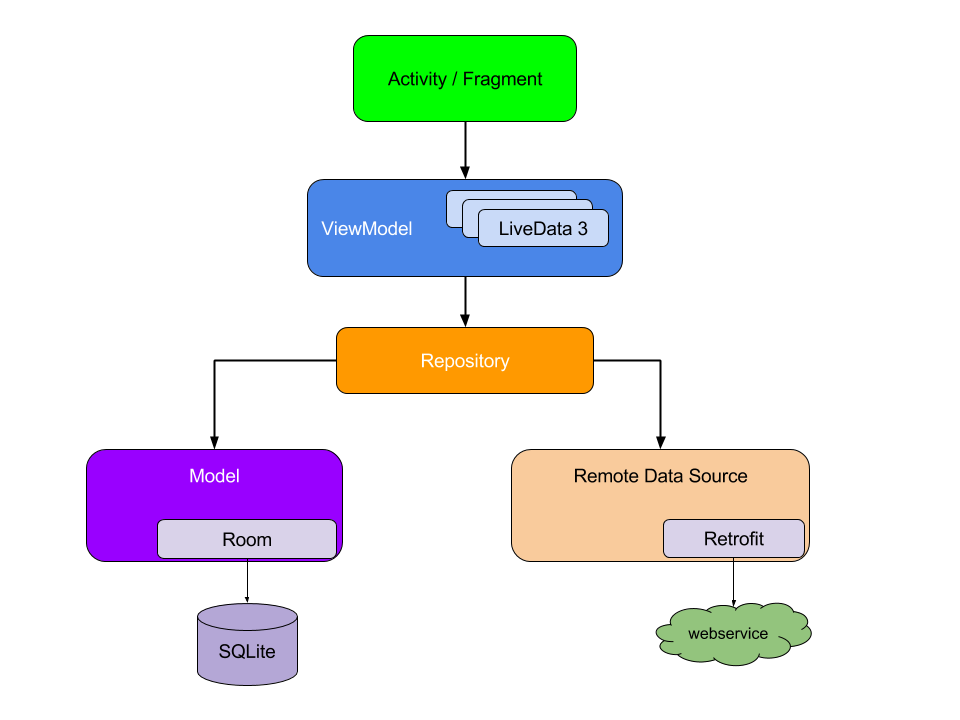Android Architecture Componets
来源:互联网 发布:办公室软件视频 编辑:程序博客网 时间:2024/05/28 23:20
Android Architecture Componets(Google官方提供的架构组件)
官网
https://developer.android.google.cn/topic/libraries/architecture/index.html
前言
Google 一直没有给Android 创建属于自己的官方架构方案,也没有官方确切的说支持MVP或者MVVM,反正什么样的架构代码的方式,Google一直都是包容的态度,在Github上也一直都有一个Android架构方案的开源项目。
https://github.com/googlesamples/android-architecture
2017 Google IO 虽然没有刻意去讨论Android,但是在Android Developer 网站上悄然出现了关于Android Architecture的东西,但并不是官方的架构方案,而是给出了一个可选的架构方案。
架构方案

Android Architecture Componets 组件
架构方案代码演示
ViewModel demo
//继承ViewModel 在新推荐的架构方案中与Ui层进行逻辑分离public class UserProfileViewModel extends ViewModel { private String userId; private LiveData<User> user; public void init(String userId) { this.userId = userId; } //使用 LiveData 包装 真实的Model对象 public LiveData<User> getUser() { return user; }}UI 层使用 ViewModel
//需要继承新的LifecycleFragment类,该类是Fragment的子类,但是该类实现了LifecycleOwner接口public class UserProfileFragment extends LifecycleFragment { private static final String UID_KEY = "uid"; private UserProfileViewModel viewModel; @Override public void onActivityCreated(@Nullable Bundle savedInstanceState) { super.onActivityCreated(savedInstanceState); String userId = getArguments().getString(UID_KEY); //获取ViweModel viewModel = ViewModelProviders.of(this).get(UserProfileViewModel.class); //滴啊用ViewModel中的业务方法 viewModel.init(userId); //使用LiveData方式获取User信息 viewModel.getUser().observe(this, user -> { // update UI }); } @Override public View onCreateView(LayoutInflater inflater, @Nullable ViewGroup container, @Nullable Bundle savedInstanceState) { return inflater.inflate(R.layout.user_profile, container, false); }}Repository
//User Dagger2 DI@Singletonpublic class UserRepository { private final Webservice webservice; private final UserDao userDao; private final Executor executor; @Inject public UserRepository(Webservice webservice, UserDao userDao, Executor executor) { this.webservice = webservice; this.userDao = userDao; this.executor = executor; } public LiveData<User> getUser(String userId) { refreshUser(userId); // return a LiveData directly from the database. return userDao.load(userId); } private void refreshUser(final String userId) { executor.execute(() -> { // running in a background thread // check if user was fetched recently boolean userExists = userDao.hasUser(FRESH_TIMEOUT); if (!userExists) { // refresh the data Response response = webservice.getUser(userId).execute(); // TODO check for error etc. // Update the database.The LiveData will automatically refresh so // we don't need to do anything else here besides updating the database userDao.save(response.body()); } }); }}WebService
//Retrofit 2 网络请求public interface Webservice { /** * @GET declares an HTTP GET request * @Path("user") annotation on the userId parameter marks it as a * replacement for the {user} placeholder in the @GET path */ @GET("/users/{user}") Call<User> getUser(@Path("user") String userId);}Room 持久化数据
Entity
@Entityclass User { @PrimaryKey private int id; private String name; private String lastName; // getters and setters for fields}Dao
@Daopublic interface UserDao { @Insert(onConflict = REPLACE) void save(User user); @Query("SELECT * FROM user WHERE id = :userId") LiveData<User> load(String userId);}RoomDatabase
@Database(entities = {User.class}, version = 1)public abstract class MyDatabase extends RoomDatabase { public abstract UserDao userDao();}依赖
项目根路径下的build.gradle 新增一下仓库
allprojects { repositories { jcenter() maven { url 'https://maven.google.com' } }}依赖
//For Lifecycles, LiveData, and ViewModel, add:compile "android.arch.lifecycle:runtime:1.0.0-alpha1"compile "android.arch.lifecycle:extensions:1.0.0-alpha1"annotationProcessor "android.arch.lifecycle:compiler:1.0.0-alpha1"//For Room, add:compile "android.arch.persistence.room:runtime:1.0.0-alpha1"annotationProcessor "android.arch.persistence.room:compiler:1.0.0-alpha1"已知限制和问题
- 测试版本的 Lifecycle Fragment 和ActivityCompat 在Support Library 中并没有实现LifecycleOwner 接口,在正式版1.0.0发布时,将正确实现。
阅读全文
0 0
- Android Architecture Componets
- Android Architecture Componets
- 简单聊聊Android Architecture Componets
- Android-Architecture-Componets官方DEMO分析
- android studio 使用kotlin编写architecture componets的配置问题
- Android Architecture
- Android Architecture
- Android Architecture
- android architecture
- android architecture
- android-architecture
- android-architecture
- Android: Android Architecture
- Android Platform architecture Android
- JSP Componets Quick summary
- Android Bluetooth Architecture
- Android Src Architecture
- Android Audio Architecture图示
- Redis动态增加节点
- 同步代码和同步方法、锁的理解
- ubuntu笔记5
- Java中创建对象的几种方式
- 程序员 很装逼的头注释
- Android Architecture Componets
- mavros 使用经验记录
- idea本地运行mapreduce程序
- Opencv 连通域分析
- 优维科技:DevOps落地经验十四则(上)
- Python的os.path常见用法
- E/dalvikvm: Could not find class 'cn.jpush.android.service.PushJobService', referenced from method c
- STM8S_004_UART基本收发数据
- EF Mappings1 Entity Mappings using Fluent API


